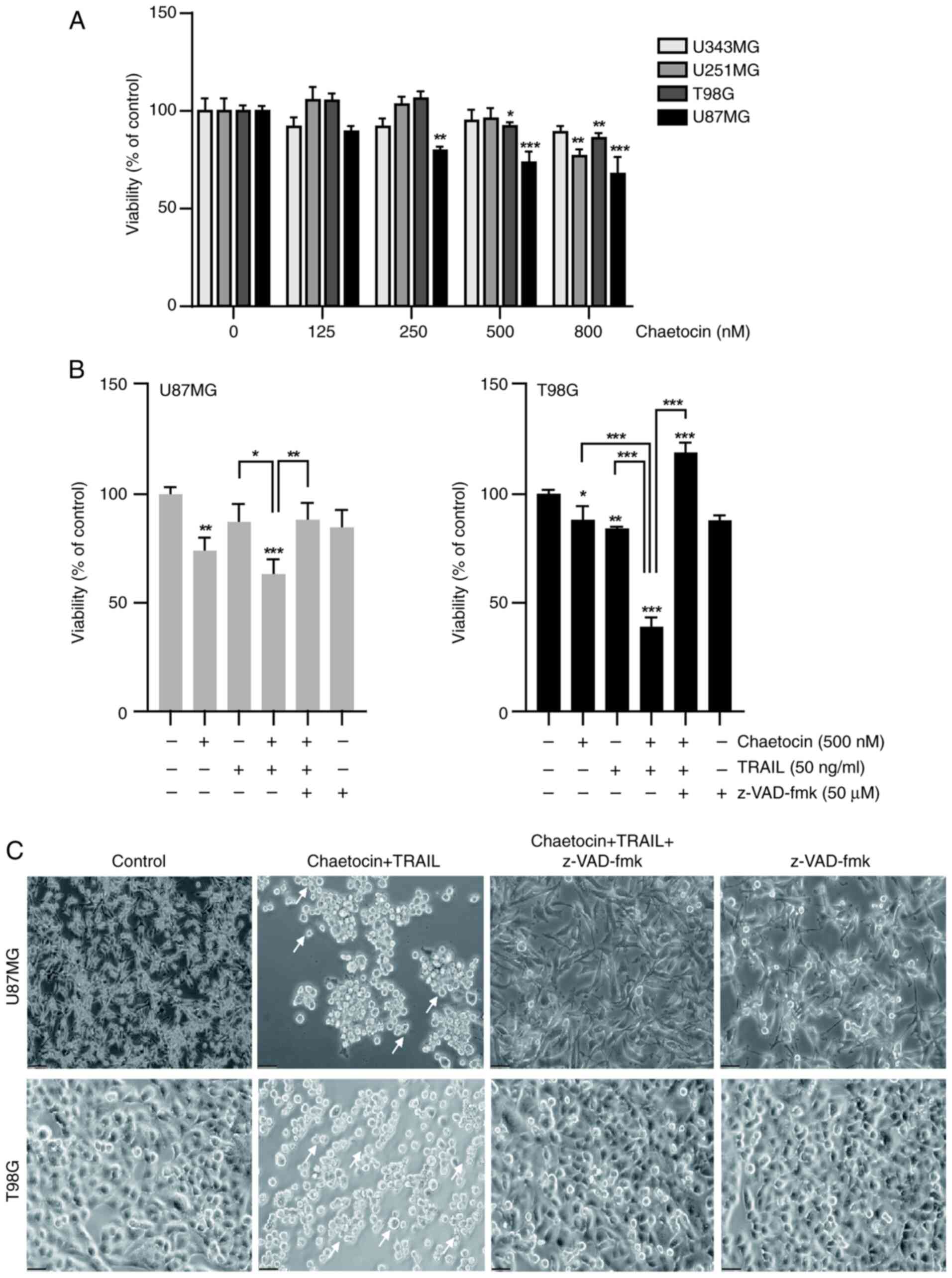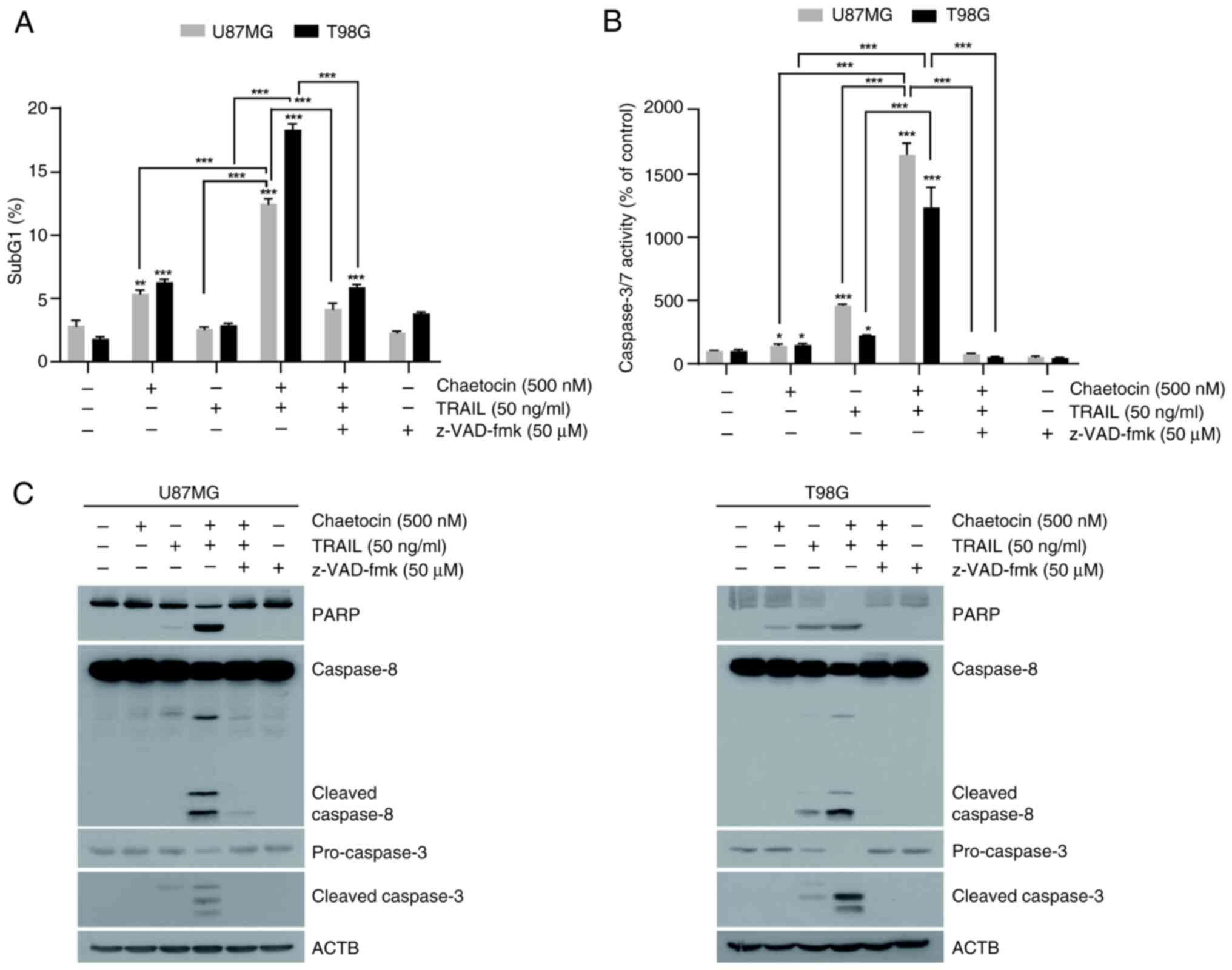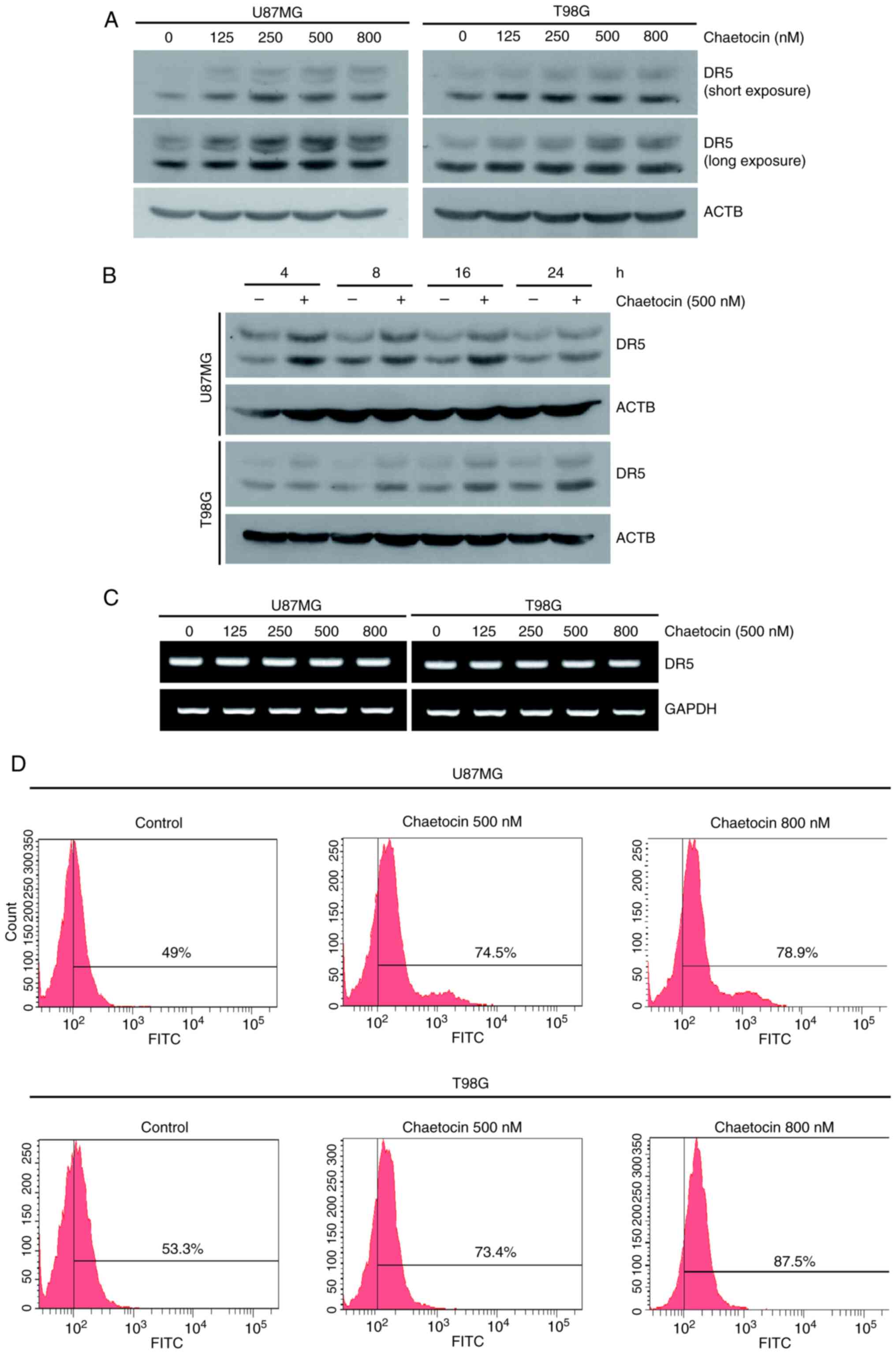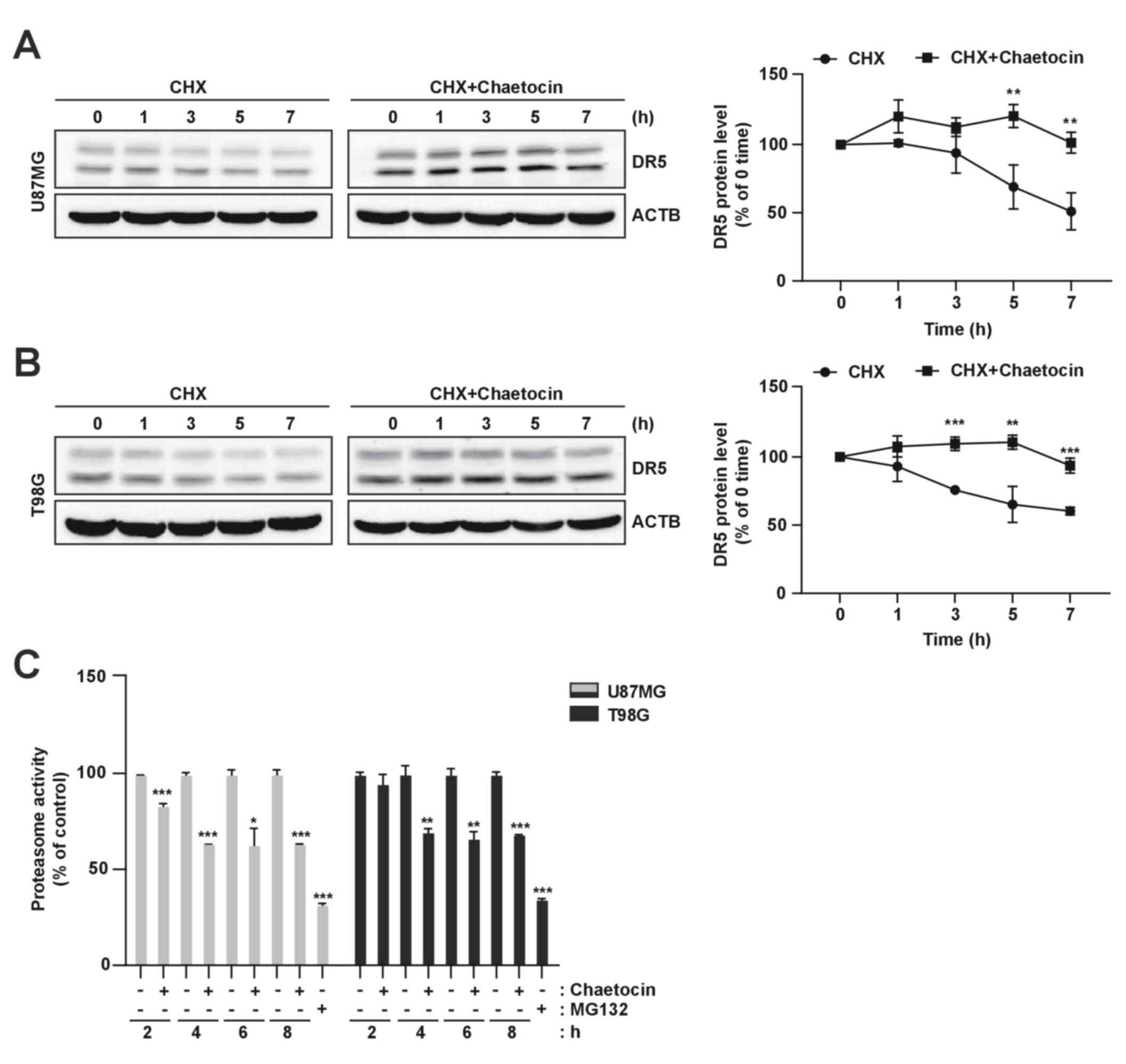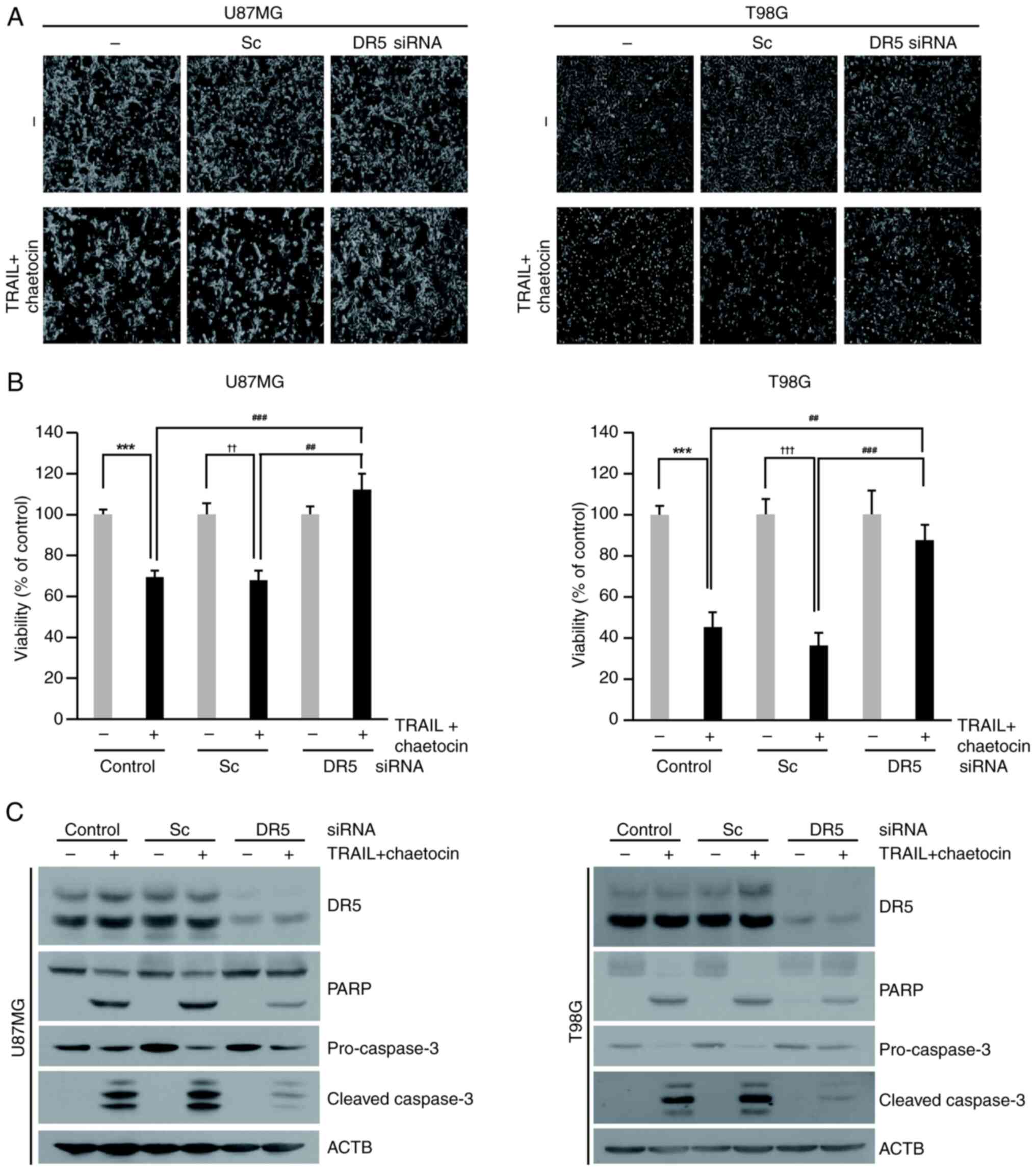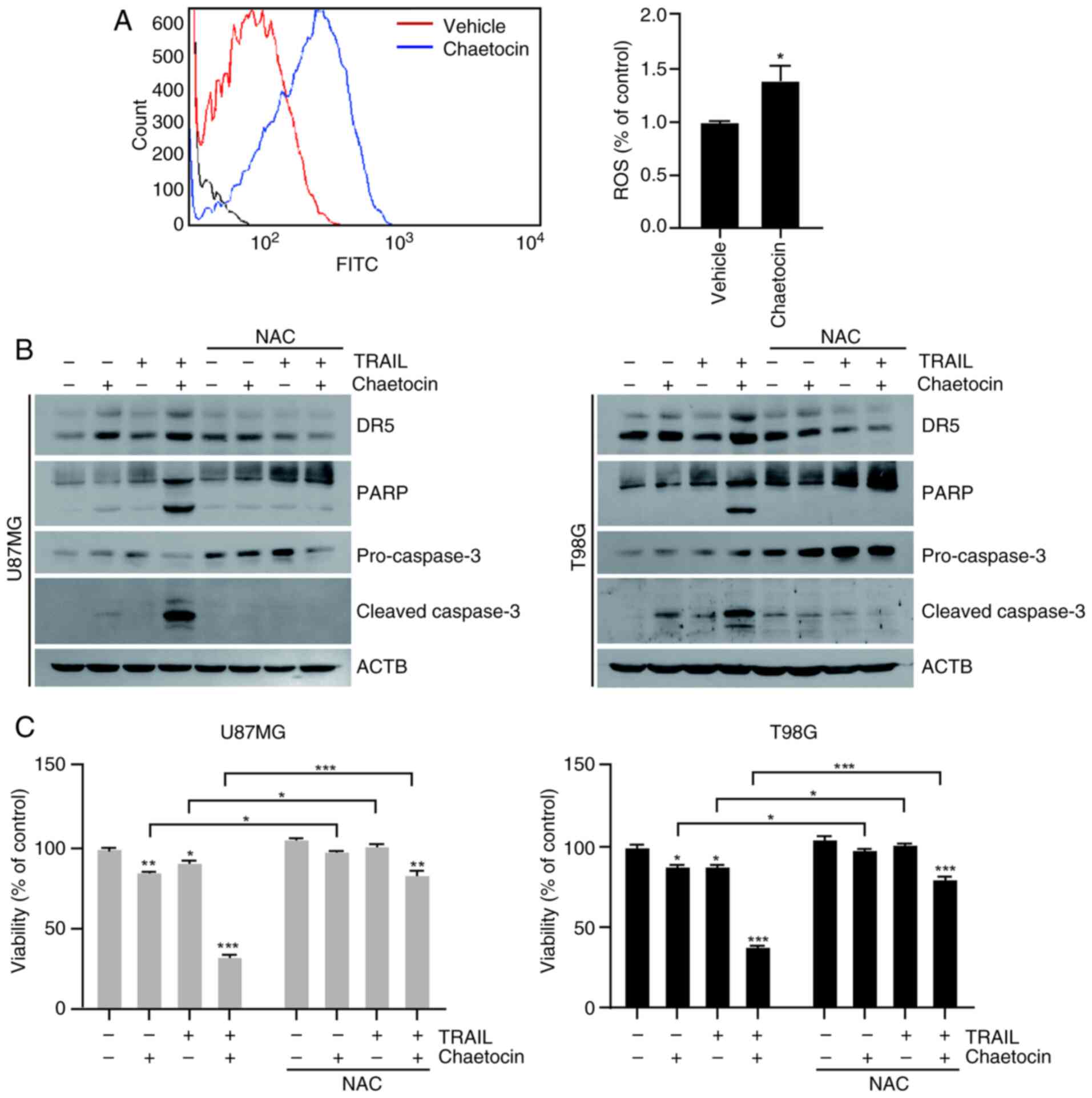|
1
|
Hanif F, Muzaffar K, Perveen K, Malhi SM
and Simjee ShU: Glioblastoma multiforme: A review of its
epidemiology and pathogenesis through clinical presentation and
treatment. Asian Pac J Cancer Prev. 18:3–9. 2017.PubMed/NCBI
|
|
2
|
Shergalis A, Bankhead A III, Luesakul U,
Muangsin N and Neamati N: Current challenges and opportunities in
treating glioblastoma. Pharmacol Rev. 70:412–445. 2018. View Article : Google Scholar : PubMed/NCBI
|
|
3
|
Dai X, Zhang J, Arfuso F, Chinnathambi A,
Zayed ME, Alharbi SA, Kumar AP, Ahn KS and Sethi G: Targeting
TNF-related apoptosis-inducing ligand (TRAIL) receptor by natural
products as a potential therapeutic approach for cancer therapy.
Exp Biol Med (Maywood). 240:760–773. 2015. View Article : Google Scholar : PubMed/NCBI
|
|
4
|
Bin L, Thorburn J, Thomas LR, Clark PE,
Humphreys R and Thorburn A: Tumor-derived mutations in the TRAIL
receptor DR5 inhibit TRAIL signaling through the DR4 receptor by
competing for ligand binding. J Biol Chem. 282:28189–28194. 2007.
View Article : Google Scholar : PubMed/NCBI
|
|
5
|
Pimentel JM, Zhou JY and Wu GS: The role
of TRAIL in apoptosis and immunosurveillance in cancer. Cancers
(Basel). 15:27522023. View Article : Google Scholar : PubMed/NCBI
|
|
6
|
Wachmann K, Pop C, van Raam BJ, Drag M,
Mace PD, Snipas SJ, Zmasek C, Schwarzenbacher R, Salvesen GS and
Riedl SJ: Activation and specificity of human caspase-10.
Biochemistry. 49:8307–8315. 2010. View Article : Google Scholar : PubMed/NCBI
|
|
7
|
Deng Y, Lin Y and Wu X: TRAIL-induced
apoptosis requires Bax-dependent mitochondrial release of
Smac/Diablo. Genes Dev. 16:33–45. 2002. View Article : Google Scholar : PubMed/NCBI
|
|
8
|
Meurette O, Rebillard A, Huc L, Le Moigne
G, Merino D, Micheau O, Lagadic-Gossmann D and Dimanche-Boitrel MT:
TRAIL induces receptor-interacting protein 1-dependent and
caspase-dependent necrosis-like cell death under acidic
extracellular conditions. Cancer Res. 67:218–226. 2007. View Article : Google Scholar : PubMed/NCBI
|
|
9
|
Kim B, Seo JH, Lee KY and Park B: Icariin
sensitizes human colon cancer cells to TRAIL-induced apoptosis via
ERK-mediated upregulation of death receptors. Int J Oncol.
56:821–834. 2020.PubMed/NCBI
|
|
10
|
Manouchehri JM, Turner KA and Kalafatis M:
TRAIL-induced apoptosis in TRAIL-resistant breast carcinoma through
quercetin cotreatment. Breast Cancer (Auckl).
12:11782234177498552018. View Article : Google Scholar : PubMed/NCBI
|
|
11
|
Liu S, Qiu J, He G, He W, Liu C, Cai D and
Pan H: TRAIL promotes hepatocellular carcinoma apoptosis and
inhibits proliferation and migration via interacting with IER3.
Cancer Cell Int. 21:632021. View Article : Google Scholar : PubMed/NCBI
|
|
12
|
Greiner D, Bonaldi T, Eskeland R, Roemer E
and Imhof A: Identification of a specific inhibitor of the histone
methyltransferase SU(VAR)3-9. Nat Chem Biol. 1:143–145. 2005.
View Article : Google Scholar
|
|
13
|
Han X, Han Y, Zheng Y, Sun Q, Ma T, Zhang
J and Xu L: Chaetocin induces apoptosis in human melanoma cells
through the generation of reactive oxygen species and the intrinsic
mitochondrial pathway, and exerts its anti-tumor activity in vivo.
PLoS One. 12:e01759502017. View Article : Google Scholar : PubMed/NCBI
|
|
14
|
Chaib H, Nebbioso A, Prebet T, Castellano
R, Garbit S, Restouin A, Vey N, Altucci L and Collette Y:
Anti-leukemia activity of chaetocin via death receptor-dependent
apoptosis and dual modulation of the histone methyl-transferase
SUV39H1. Leukemia. 26:662–674. 2012. View Article : Google Scholar
|
|
15
|
Liu X, Guo S, Liu X and Su L: Chaetocin
induces endoplasmic reticulum stress response and leads to death
receptor 5-dependent apoptosis in human non-small cell lung cancer
cells. Apoptosis. 20:1499–1507. 2015. View Article : Google Scholar : PubMed/NCBI
|
|
16
|
Jung HJ, Seo I, Jha BK, Suh SI and Baek
WK: Miconazole induces autophagic death in glioblastoma cells via
reactive oxygen species-mediated endoplasmic reticulum stress.
Oncol Lett. 21:3352021. View Article : Google Scholar : PubMed/NCBI
|
|
17
|
Livak KJ and Schmittgen TD: Analysis of
relative gene expression data using real-time quantitative PCR and
the 2(-Delta Delta C(T)) method. Methods. 25:402–408. 2001.
View Article : Google Scholar
|
|
18
|
Yamamoto K, Makino M, Watanapokasin R,
Tashiro E and Imoto M: Inostamycin enhanced TRAIL-induced apoptosis
through DR5 upregulation on the cell surface. J Antibiot (Tokyo).
65:295–300. 2012. View Article : Google Scholar : PubMed/NCBI
|
|
19
|
Dilshara MG, Jayasooriya RGPT, Molagoda
IMN, Jeong JW, Lee S, Park SR, Kim GY and Choi YH: Silibinin
sensitizes TRAIL-mediated apoptosis by upregulating DR5 through
ROS-induced endoplasmic reticulum stress-Ca2+-CaMKII-Sp1
pathway. Oncotarget. 9:10324–10342. 2018. View Article : Google Scholar : PubMed/NCBI
|
|
20
|
Yodkeeree S, Sung B, Limtrakul P and
Aggarwal BB: Zerumbone enhances TRAIL-induced apoptosis through the
induction of death receptors in human colon cancer cells: Evidence
for an essential role of reactive oxygen species. Cancer Res.
69:6581–6589. 2009. View Article : Google Scholar : PubMed/NCBI
|
|
21
|
Hori T, Kondo T, Kanamori M, Tabuchi Y,
Ogawa R, Zhao QL, Ahmed K, Yasuda T, Seki S, Suzuki K and Kimura T:
Nutlin-3 enhances tumor necrosis factor-related apoptosis-inducing
ligand (TRAIL)-induced apoptosis through up-regulation of death
receptor 5 (DR5) in human sarcoma HOS cells and human colon cancer
HCT116 cells. Cancer Lett. 287:98–108. 2010. View Article : Google Scholar
|
|
22
|
Wang W and El-Deiry WS: Requirement of p53
targets in chemosensitization of colonic carcinoma to death ligand
therapy. Proc Natl Acad Sci USA. 9:15095–15100. 2003. View Article : Google Scholar
|
|
23
|
Lu M, Lawrence DA, Marsters S,
Acosta-Alvear D, Kimmig P, Mendez AS, Paton AW, Paton JC, Walter P
and Ashkenazi A: Opposing unfolded-protein-response signals
converge on death receptor 5 to control apoptosis. Science.
345:98–101. 2014. View Article : Google Scholar : PubMed/NCBI
|
|
24
|
Yue D and Sun X: Ixazomib promotes
CHOP-dependent DR5 induction and apoptosis in colorectal cancer
cells. Cancer Biol Ther. 20:284–294. 2019. View Article : Google Scholar :
|
|
25
|
Kong F, You H, Zhao J, Liu W, Hu L, Luo W,
Hu W, Tang R and Zheng K: The enhanced expression of death receptor
5 (DR5) mediated by HBV X protein through NF-kappaB pathway is
associated with cell apoptosis induced by (TNF-α related apoptosis
inducing ligand) TRAIL in hepatoma cells. Virol J. 12:1922015.
View Article : Google Scholar
|
|
26
|
Sekita S, Yoshihira K, Natori S, Udagawa
S, Muroi T, Sugiyama Y, Kurata H and Umeda M: Mycotoxin production
by Chaetomium spp and related fungi. Can J Microbiol. 27:766–772.
1981. View
Article : Google Scholar : PubMed/NCBI
|
|
27
|
Wang H, Wen C, Chen S, Li W, Qin Q, He L,
Wang F, Chen J, Ye W, Li W, et al: ROS/JNK/C-jun pathway is
involved in chaetocin induced colorectal cancer cells apoptosis and
macrophage phagocytosis enhancement. Front Pharmacol.
12:7293672021. View Article : Google Scholar : PubMed/NCBI
|
|
28
|
Li Z, Huang L, Wei L, Hou Z, Ye W and
Huang S: Chaetocin induces caspase-dependent apoptosis in ovarian
cancer cells via the generation of reactive oxygen species. Oncol
Lett. 18:1915–1921. 2019.PubMed/NCBI
|
|
29
|
Jung HJ, Seo I, Casciello F, Jacquelin S,
Lane SW, Suh SI, Suh MH, Lee JS and Baek WK: The anticancer effect
of chaetocin is enhanced by inhibition of autophagy. Cell Death
Dis. 7:e20982016. View Article : Google Scholar : PubMed/NCBI
|
|
30
|
Holoch PA and Griffith TS: TNF-related
apoptosis-inducing ligand (TRAIL): A new path to anti-cancer
therapies. Eur J Pharmacol. 625:63–72. 2009. View Article : Google Scholar : PubMed/NCBI
|
|
31
|
LeBlanc HN and Ashkenazi A: Apo2L/TRAIL
and its death and decoy receptors. Cell Death Differ. 10:66–75.
2003. View Article : Google Scholar : PubMed/NCBI
|
|
32
|
Wang S and El-Deiry WS: TRAIL and
apoptosis induction by TNF-family death receptors. Oncogene.
22:8628–8633. 2003. View Article : Google Scholar : PubMed/NCBI
|
|
33
|
Son YG, Kim EH, Kim JY, Kim SU, Kwon TK,
Yoon AR, Yun CO and Choi KS: Silibinin sensitizes human glioma
cells to TRAIL-mediated apoptosis via DR5 up-regulation and
down-regulation of c-FLIP and survivin. Cancer Res. 67:8274–8284.
2007. View Article : Google Scholar : PubMed/NCBI
|
|
34
|
Senbabaoglu F, Cingoz A, Kaya E,
Kazancioglu S, Lack NA, Acilan C and Bagci-Onder T: Identification
of mitoxantrone as a TRAIL-sensitizing agent for glioblastoma
multiforme. Cancer Biol Ther. 17:546–557. 2016. View Article : Google Scholar : PubMed/NCBI
|
|
35
|
Liu PC, Lu G, Deng Y, Wang CD, Su XW, Zhou
JY, Chan TM, Hu X and Poon WS: Inhibition of NF-κB pathway and
modulation of MAPK signaling pathways in glioblastoma and
implications for lovastatin and tumor necrosis factor-related
apoptosis inducing ligand (TRAIL) combination therapy. PLoS One.
12:e01711572017. View Article : Google Scholar
|
|
36
|
Аrtykov АА, Belov DA, Shipunova VO,
Trushina DB, Deyev SM, Dolgikh DA, Kirpichnikov MP and Gasparian
ME: Chemotherapeutic agents sensitize resistant cancer cells to the
DR5-specific variant DR5-B more efficiently than to TRAIL by
modulating the surface expression of death and decoy receptors.
Cancers (Basel). 12:11292020. View Article : Google Scholar : PubMed/NCBI
|
|
37
|
Gibson SB, Oyer R, Spalding AC, Anderson
SM and Johnson GL: Increased expression of death receptors 4 and 5
synergizes the apoptosis response to combined treatment with
etoposide and TRAIL. Mol Cell Biol. 20:205–212. 2000. View Article : Google Scholar
|
|
38
|
Ozyerli-Goknar E, Sur-Erdem I, Seker F,
Cingöz A, Kayabolen A, Kahya-Yesil Z, Uyulur F, Gezen M, Tolay N,
Erman B, et al: The fungal metabolite chaetocin is a sensitizer for
pro-apoptotic therapies in glioblastoma. Cell Death Dis.
10:8942019. View Article : Google Scholar : PubMed/NCBI
|
|
39
|
Mandal PK, Schneider M, Kölle P,
Kuhlencordt P, Förster H, Beck H, Bornkamm GW and Conrad M: Loss of
thioredoxin reductase 1 renders tumors highly susceptible to
pharmacologic glutathione deprivation. Cancer Res. 70:9505–9514.
2010. View Article : Google Scholar : PubMed/NCBI
|
|
40
|
Sporn MB and Liby KT: NRF2 and cancer: The
good, the bad and the importance of context. Nat Rev Cancer.
12:564–571. 2012. View Article : Google Scholar : PubMed/NCBI
|
|
41
|
Yamaguchi H and Wang HG: CHOP is involved
in endoplasmic reticulum stress-induced apoptosis by enhancing DR5
expression in human carcinoma cells. J Biol Chem. 279:45495–45502.
2004. View Article : Google Scholar : PubMed/NCBI
|
|
42
|
Taniguchi H, Yoshida T, Horinaka M, Yasuda
T, Goda AE, Konishi M, Wakada M, Kataoka K, Yoshikawa T and Sakai
T: Baicalein overcomes tumor necrosis factor-related
apoptosis-inducing ligand resistance via two different
cell-specific pathways in cancer cells but not in normal cells.
Cancer Res. 68:8918–8927. 2008. View Article : Google Scholar : PubMed/NCBI
|
|
43
|
Shin D, Kwon HY, Sohn EJ, Nam MS, Kim JH,
Lee JC, Ryu SY, Park B and Kim SH: Upregulation of death receptor 5
and production of reactive oxygen species mediate sensitization of
PC-3 prostate cancer cells to TRAIL induced apoptosis by vitisin A.
Cell Physiol Biochem. 36:1151–1162. 2015. View Article : Google Scholar : PubMed/NCBI
|















